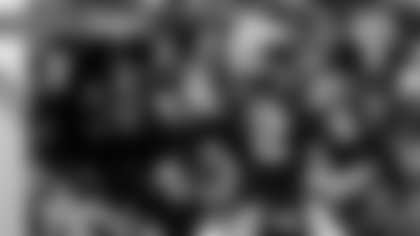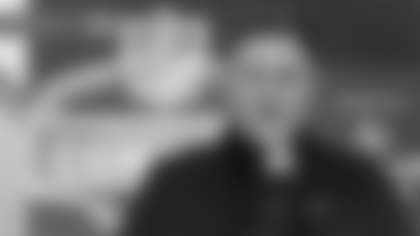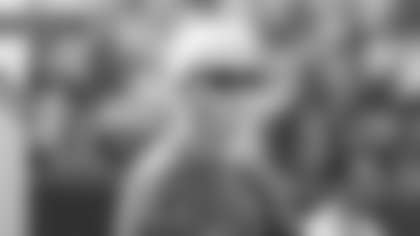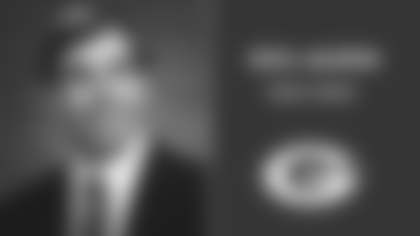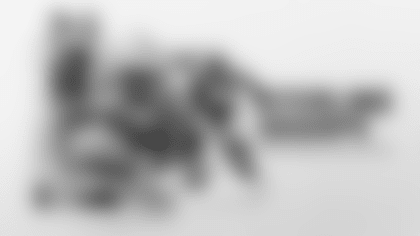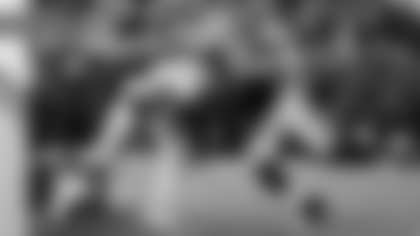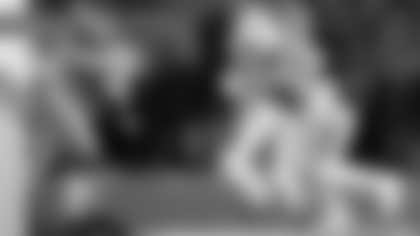The roots of the best teams, particularly the most memorable rosters that grow into Super Bowl champions, are the draft classes that precede them. Scan through the Packers of today, the 1990s or the Lombardi dynasties and the drafts of the years before are littered with the players who developed into the foundation of those great teams. Building through the inexact science that is the draft is the Packers' way.
So what are the best indicators of a top draft class? Is it just a few standouts or overall quality? There's no denying an exceptional group when it only includes two or three terrific players. Another factor is how many individuals become starters or top contributors early in their careers, and how much success follows the group's arrival.
In 1956 and '58, the Packers selected a pair of Hall of Famers, and only three other draft classes in NFL history have produced more Hall of Fame inductees: the Steelers' epic class from '74 (Lynn Swann, Jack Lambert, John Stallworth and Mike Webster); Cleveland's three in '57 (Jim Brown, Henry Jordan – voted in primarily on his merits after being traded to the Packers in '59 – and Gene Hickerson); and the Cowboys' trio from '64 (Mel Renfro, Bob Hayes and Roger Staubach).
In NFL history, the Pittsburgh draft class of '74 provides clear evidence of the argument of numbers vs. quality. Four years earlier, the Steelers selected two players who were voted to the Hall of Fame: No. 1 QB Terry Bradshaw in the first round and third-round pick Mel Blount at cornerback. As the franchise quarterback, Bradshaw was the central figure in the Steelers' four title teams. With QBs who prove to be the catalyst for long-term success, there's always a different curve.
Also, trades come into the equation. NFL teams often look at dealing picks for players as part of that year's draft haul. What follows is one opinion of the Packers' top 10 draft classes in club history.
10. 1952 – While the Packers of the 1950s weren't the annual contenders of the next decade, this class was a quality unit. QB Babe Parilli only started 13 games in Green Bay after being selected fourth overall, but he moved on to the Patriots where he was a record-breaking passer in the AFL.
The next three picks were solid, long-term acquisitions for the Packers. Wide receiver Billy Howton, taken in the second round out of Rice, had 302 catches for 5,581 yards and 43 TDs. Including his rookie season, Howton twice led the NFL in receiving yardage and led the league in touchdown receptions in 1956 with 12.
In the third round, the team selected defensive back Bobby Dillon, a four-time All-Pro who holds the team record with 52 career interceptions and returned five for touchdowns. Dillon led the team in interceptions seven of his eight seasons.
In the fifth round, the club chose defensive tackle Dave Hanner. Nicknamed "Hawg," Hanner played in 160 games, was voted to the Pro Bowl in '53 and '54 and started on the '61 and '62 NFL Championship teams.
9. 1990– The Packers opened the decade with a draft that brought in players that would be key performers in the coming seasons as the club shook off the 1980s. Linebacker Tony Bennett, selected 18th overall, would notch 36 sacks in 56 games in Green Bay, including ranking sixth in the NFL in '91 with 13. Safety LeRoy Butler of Florida State was taken 48th overall in the second round, and he emerged as one of the NFL's most consistent defenders over the next 12 seasons and was a four-time All-Pro.
Fourth-round pick Jackie Harris had 133 catches for the Packers from 1990-93 and played in the NFL for 12 years. Green Bay selected Bryce Paup in the sixth round out of Northern Iowa, and the linebacker had 32.5 sacks while opening 41 of 54 games. Paup was voted to the Pro Bowl in '94, his final year in Green Bay, and the following season was named the AP Defensive Player of the Year with Buffalo.
8. 2000 – This was a draft that brought in a legion of big men. TE Bubba Franks was selected 14th overall, and before departing in '07 he made three trips to the Pro Bowl and scored 31 touchdowns. Second-round pick Chad Clifton is still going strong after being taken 44th overall, with Super Bowl XLV marking the 171st career start for the left tackle. LB Na'il Diggs, the team's fourth-round pick at 98th overall, earned all-rookie accolades and played in 84 games before his departure in '05.
In the fifth round, the team selected Kabeer Gbaja-Biamila, who closed his career in '08 as the club's all-time leading sacker with 74.5. T Mark Tauscher of Wisconsin was taken at 224th overall, and he has served as a bookend with Clifton in the years since.
A notable trade was also consummated in this draft, with the Packers packaging their sixth-round choice along with CB Fred Vinson and sending them to Seattle for RB Ahman Green, who developed into Green Bay's all-time leading rusher.
7. 2006– The class brought in five players who were starters by their second year – linebacker A.J. Hawk, guard Daryn Colledge, wide receiver Greg Jennings, guard Jason Spitz and defensive lineman Johnny Jolly. Hawk made the Pro Bowl for the first time in 2010 and has led the club or finished second in tackles every season since joining the club. Jennings made the Pro Bowl last year, has notched three straight 1,000-yard seasons and scored 40 TDs.
Colledge has opened 76 contests in his career, primarily at guard. Spitz has started at center and both guard spots, opening 45 of 65 games. Before his legal problems in recent seasons, Jolly was a solid defender up front. The class of '06 proved to be part of the backbone of the Super Bowl XLV title team.
6. 2005– The perfect example of a draft notable for its quality as opposed to its quantity, Aaron Rodgers memorably fell to the Packers at 24th overall, and he has developed into one of the NFL's best quarterbacks. In the second round, GM Ted Thompson selected S/CB Nick Collins out of Bethune-Cookman, who has been voted to the last three Pro Bowls.
The only other player from the group still on the roster is linebacker Brady Poppinga of BYU, selected 125th overall in the fourth round. Though he suffered a knee injury after six contests last year, Poppinga has started 44 of 81 games since his arrival. In a time when the NFL is dominated by the quarterback, history is already showing landing Rodgers – a Super Bowl MVP still improving – makes the 2005 draft class among the Packers' best.
5. 1957– Gaining the first overall pick as a bonus choice from the final year of the annual draft lottery, Green Bay selected Heisman Trophy winner Paul Hornung of Notre Dame. The multi-talented Hornung was inducted into the Hall of Fame in 1986.
With the fourth overall selection, the Packers selected Ron Kramer, a rugged blocker who was one of the NFL's top tight ends of his era. Kramer was dominant from 1960-64, catching 142 passes for 2,257 yards and 15 TDs. The Michigan native was traded to the Lions in '65 by request for personal reasons.
In the 23rd round, the Packers selected John Symank 268th overall out of Florida. The defensive back would intercept 18 passes before being traded in 1962, including nine as a rookie. Symank tied for the team lead with five interceptions on the 1961 NFL title team.
4. 1995 – While only No. 1 pick Craig Newsome earned a starting spot as a rookie, five players from this draft haul were in the lineup in 1996 on a club that went 13-3 and won Super Bowl XXXI. Two third-round picks proved to be the real gems. FB William Henderson was a rugged blocker and played in 188 games, catching 320 passes and making the Pro Bowl in 2004. Fellow third-rounder Antonio Freeman had 431 career receptions for 6,651 yards and 61 TDs.
LB Brian Williams played for the Packers until 2000, appearing in 72 contests.
The final player the club selected in '95 was guard Adam Timmerman, who opened every game with the Packers from '96-'98 before departing as a free agent. In '95, the club also selected DT Darius Holland as the first of their four third-round picks, a reserve who played in 42 contests, and RB Travis Jervey in the fifth round, a backup who played for the Packers for four years and made the Pro Bowl as a special teamer in '97.
3. 1992 – This was the first draft of former GM Ron Wolf – a key figure in turning around a franchise that had struggled for a quarter-century – and remarkable for the players he brought in, as well as the trades he engineered. The Packers traded their second No. 1, the 17th overall pick, to Atlanta for QB Brett Favre, solidifying the position for the next 16 seasons.
With the fifth overall selection, Green Bay chose CB Terrell Buckley, who would open 44 of 46 games in Green Bay before departing in 1995. The 45th overall pick in the second round was dealt to San Francisco as compensation for hiring Mike Holmgren as head coach.
In the third round, Green Bay took wide receiver Robert Brooks, a speedy target who would haul in 305 passes for 4,225 yards and 32 touchdowns. The fourth round brought Florida State fullback Edgar Bennett, a stalwart for five seasons, and sixth-rounder Mark Chmura was one of the NFL's top tight ends in the mid-1990s while being voted to three Pro Bowls.
2. 1958– This one reads like a "Who's Who" in Packers lore, and the three main characters were part of five NFL titles, including the first two Super Bowls. Two Pro Football Hall of Fame inductees were included: second-rounder FB Jim Taylor and third-round pick LB Ray Nitschke. Taylor arrived in Canton in 1976 after rushing for over 1,000 yards for five straight seasons and being named to five Pro Bowls during his nine years in Green Bay. Nitschke, inducted to the Hall of Fame in 1978, played in 190 games and was named to the NFL's 50th and 75th anniversary teams. The team's practice field is named after him.
In the fourth round, the Packers chose G Jerry Kramer, the only member of the NFL's 50th Anniversary team not voted into the Hall of Fame. Kramer was a five-time All-Pro. He also served as kicker from 1962-63, including drilling three field goals in the 16-7 victory over the Giants for the '62 NFL title game.
The club's overshadowed No. 1 pick was LB Dan Currie, who played in 90 games, went to the Pro Bowl in '60, was an All-Pro in '62 and started on two championship teams.
1. 1956 – Another Packers' draft that featured a pair of Hall of Famers, tackle Forrest Gregg in the second round at 20th overall and QB Bart Starr, taken in the 17th round at 200th. Fittingly, both were inducted into the Hall of Fame in 1977. Gregg was a nine-time Pro-Bowl pick and Starr was voted to the postseason all-star game five times.
The draft also mined a couple of other quality players. Fifth-rounder Bob Skoronski, a tackle out of the University of Indiana, played in 146 games, made the Pro Bowl in '66 and was a starter on all five NFL Championship teams of the 1960s.
Seventh-round choice Hank Gremminger, taken 80th overall out of Baylor, played in Green Bay until '65 and had 28 interceptions at defensive back.
Vince Lombardi considered Gregg the greatest player he ever coached. Adding Starr, a two-time Super Bowl MVP at quarterback, at the bargain-basement price of the 200th overall choice, puts the 1956 draft over the top.



